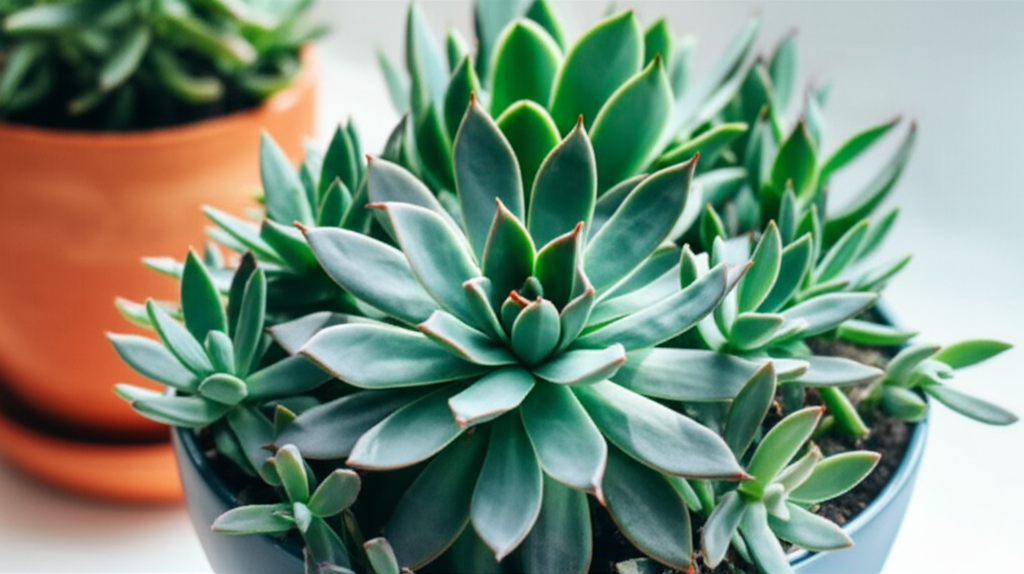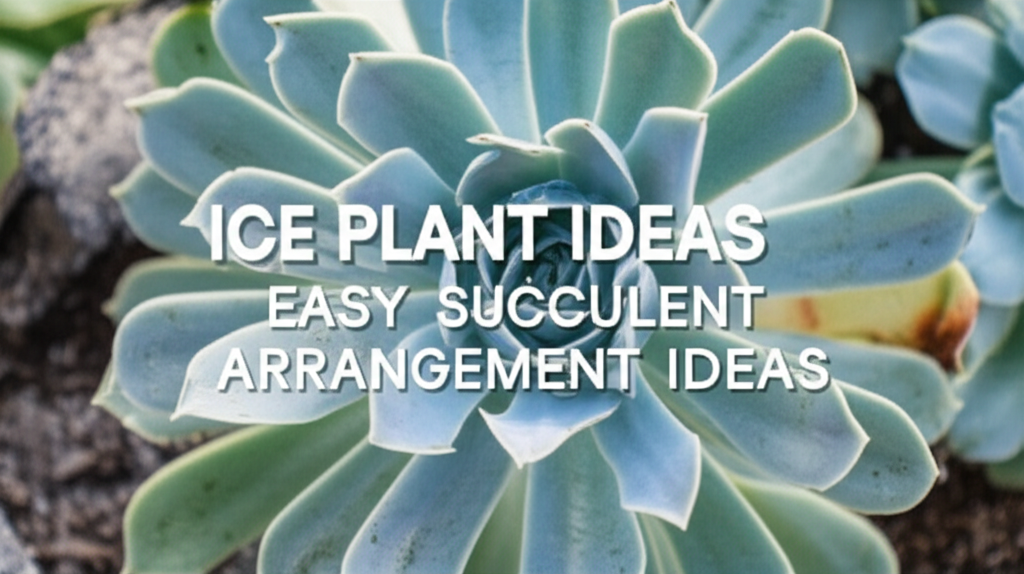Unveiling the Allure of Ice Plant Succulents
Ice plants, belonging to the Aizoaceae family, are a diverse group of succulents renowned for their striking beauty and remarkable resilience. Their name, “ice plant,” often refers to the characteristic glimmering epidermal cells, known as papillae or bladdery hairs, that cover their leaves and stems. These structures refract sunlight, creating an effect that resembles frost or ice crystals, making them truly captivating additions to any succulent collection. Beyond their aesthetic appeal, ice plants are celebrated for their ease of care, making them ideal choices for both novice and experienced succulent enthusiasts.
The variety within the ice plant family is astounding. From the vibrant, daisy-like flowers of Delosperma to the architectural forms of Lithops (living stones) and the trailing habits of Aptenia, there’s an ice plant to suit every taste and planting scenario. Their adaptability to arid environments, coupled with their low maintenance requirements, positions them as perfect candidates for creative and stunning succulent arrangements.
Why Choose Ice Plants for Your Arrangements?
Several compelling reasons make ice plant succulents the stars of many arrangement designs:
- Exceptional Drought Tolerance: Like most succulents, ice plants store water in their leaves, stems, and roots, allowing them to thrive in dry conditions and requiring minimal watering.
- Low Maintenance: They are generally pest-resistant and do not demand frequent repotting or special soil mixes.
- Diverse Forms and Textures: The sheer variety of shapes, sizes, and colors available in ice plants offers immense creative freedom for arrangements.
- Striking Visual Appeal: The “ice-like” papillae, coupled with their often vibrant blooms, create a unique and eye-catching aesthetic.
- Adaptability: Many ice plant varieties are hardy and can tolerate a range of temperatures, making them suitable for both indoor and outdoor displays.
Key Facts About Ice Plant Succulents

Understanding the fundamental characteristics of ice plant succulents is crucial for successful arrangement planning.
| Characteristic | Description |
|---|---|
| Family | Aizoaceae |
| Water Storage | Leaves, stems, and roots |
| Sunlight Requirements | Full sun to partial shade (depending on species) |
| Soil Preference | Well-draining, gritty mix (e.g., cactus and succulent mix) |
| Hardiness Zones | Varies by species, generally USDA Zones 8-11 (many are annuals or overwinter indoors in colder climates) |
| Key Feature | Epidermal papillae (bladdery hairs) that create a glistening or frosted appearance. |
| Common Genera | Delosperma, Lithops, Aptenia, Mesembryanthemum, Conophytum |
Easy Ice Plant Arrangement Ideas: A Step-by-Step Guide
Creating beautiful ice plant succulent arrangements doesn’t have to be complicated. With a few simple principles and some creative flair, you can craft stunning displays that will be the envy of all.
Step 1: Choosing Your Ice Plants
The foundation of any successful arrangement lies in selecting the right plants. Consider the growth habits, colors, and textures of various ice plants to create visual interest.
- Trailing Varieties: Aptenia cordifolia (Heartleaf Ice Plant) is a classic choice with its heart-shaped leaves and pinkish-purple flowers. Its trailing habit makes it perfect for spillover effects in hanging baskets or elevated containers.
- Upright/Mounding Varieties: Delosperma species, such as Delosperma cooperi (Cooper’s Ice Plant), offer vibrant, daisy-like flowers in shades of purple, pink, and red, with a mounding or spreading habit.
- Unique Forms: Lithops (Living Stones) are fascinating as they mimic pebbles, adding a sculptural element. However, they have specific watering needs and are best kept in arrangements with similar moisture requirements.
- Groundcover Types: Some ice plants, like Mesembryanthemum crystallinum (Common Ice Plant), can spread to form dense mats, ideal for filling larger containers or creating a carpet effect.
Step 2: Selecting the Perfect Container
The container you choose plays a significant role in the overall aesthetic of your arrangement.
- Drainage is Key: Regardless of the material, ensure your container has ample drainage holes. Succulents are prone to root rot if their roots sit in water.
- Material Matters: Terracotta pots offer excellent breathability and drainage, while ceramic or glazed pots can add a touch of elegance. For outdoor arrangements, consider weather-resistant materials like concrete or metal.
- Size and Depth: Choose a container that is proportionate to the size of your plants. A shallow, wide bowl is ideal for showcasing trailing varieties, while a deeper pot can accommodate plants with slightly larger root systems.
Step 3: Crafting the Soil Mix
A well-draining soil mix is non-negotiable for succulent health. A standard cactus and succulent potting mix is a good starting point. You can further enhance drainage by adding:
- Perlite
- Pumice
- Coarse sand
A good ratio is typically 2 parts potting mix to 1 part perlite or pumice.
Step 4: The Art of Arrangement
This is where your creativity shines! Consider these principles to create a harmonious and visually appealing arrangement.
- Height and Texture Variation: Combine plants with different heights and textures. Place taller or mounding plants towards the center or back, and trailing varieties along the edges to create a cascading effect.
- Color Harmony: Mix and match colors thoughtfully. Consider contrasting colors for a vibrant display or analogous colors for a more subtle, harmonious look. The bright blooms of Delosperma can be stunning against the subtle greens and purples of other ice plants.
- Focal Point: Choose one or two standout plants to act as a focal point. This could be a particularly striking Lithops specimen or a Delosperma with exceptionally vibrant flowers.
- Filling Gaps: Use smaller ice plants or decorative gravel to fill any empty spaces and create a polished look.
Step 5: Planting and Initial Care
Once you have your plants and container, it’s time to plant.
- Gently remove plants from their nursery pots.
- Loosen any compacted roots.
- Place the plants in the container according to your design.
- Fill the remaining space with your prepared soil mix, ensuring the base of the plants is at the soil line.
- Allow the arrangement to settle for a few days before watering lightly. This allows any damaged roots to callous over, preventing rot.
Popular Ice Plant Arrangement Themes
Beyond the general steps, specific themes can elevate your ice plant arrangements.
The “Desert Oasis” Arrangement
This theme embraces the arid origins of succulents, using natural elements to create a miniature desert landscape.
- Plant Selection: Focus on Lithops, Conophytum, and smaller Delosperma varieties with muted colors.
- Container: A shallow, wide terracotta or concrete planter works well.
- Soil & Top Dressing: Use a very gritty succulent mix and top with a layer of coarse sand, small pebbles, or gravel in earthy tones.
- Accents: Add small pieces of driftwood, interesting stones, or even a miniature ceramic cactus for a touch of realism.
The “Cascading Jewel” Arrangement
This design highlights the trailing nature of some ice plants, creating a waterfall of color and texture.
- Plant Selection: Aptenia cordifolia and other trailing ice plants are essential. Combine them with mounding Delosperma for contrast.
- Container: A hanging basket, a wall-mounted planter, or a tall, narrow pot that allows for spillover.
- Color Palette: Embrace vibrant colors. Mix pinks, purples, and reds for a dramatic effect.
- Placement: Position trailing plants near the edges so they can naturally cascade downwards.
The “Modern Minimalist” Arrangement
This approach focuses on clean lines, simple forms, and a limited color palette for a sophisticated look.
- Plant Selection: Choose plants with interesting geometric shapes or subtle colors. Consider a few Lithops specimens or a single, well-formed Delosperma.
- Container: A sleek, geometric ceramic pot in a neutral color like white, grey, or black.
- Soil & Top Dressing: Use a fine, uniform layer of white or black gravel for a clean finish.
- Composition: Keep the arrangement sparse, allowing each plant to be appreciated individually.
Pros and Cons of Ice Plant Arrangements
Like any gardening endeavor, there are advantages and disadvantages to consider when creating ice plant arrangements.
| Pros | Cons |
|---|---|
| Low Maintenance: Ideal for busy individuals or those new to plant care. | Overwatering Risk: The most common mistake, leading to root rot. Proper drainage and careful watering are crucial. |
| Drought Tolerant: Can withstand periods of neglect due to their water-storing capabilities. | Cold Sensitivity: Many ice plants are not frost-tolerant and may need to be brought indoors during winter in colder climates. |
| Aesthetically Pleasing: The unique “ice” effect and vibrant flowers offer significant visual appeal. | Pest Vulnerability (Less Common): While generally resistant, they can occasionally be susceptible to mealybugs or aphids if conditions are poor. |
| Versatile: Can be adapted to various container styles and themes. | Specific Needs of Some Varieties: Lithops, for instance, require very precise watering and dormancy periods, which can be challenging for beginners. |
| Propagation Ease: Many ice plants are easily propagated from stem cuttings or leaf cuttings. | Limited Bloom Times for Some: While many Delosperma bloom prolifically, some other ice plant varieties may have shorter or less noticeable flowering periods. |
Caring for Your Ice Plant Arrangements
Once your arrangement is complete, consistent and appropriate care will ensure its longevity and beauty.
Watering
- Less is More: Water thoroughly only when the soil is completely dry. Stick your finger about an inch into the soil; if it feels dry, it’s time to water.
- Water the Soil, Not the Leaves: Aim to water the soil directly to avoid wetting the “ice” crystals, which can sometimes lead to fungal issues.
- Seasonal Adjustments: Reduce watering significantly during winter or cooler months when the plants are dormant or growing slowly.
Sunlight
- Bright Light is Best: Most ice plants thrive in full sun to bright, indirect light.
- Acclimatization: If moving your arrangement to a sunnier spot, do so gradually to prevent sunburn.
Fertilizing
- Diluted Feeding: Ice plants are not heavy feeders. Use a diluted, balanced liquid fertilizer or a specific cactus/succulent fertilizer once or twice during the active growing season (spring/summer).
- Avoid Over-Fertilizing: Too much fertilizer can lead to leggy growth and reduce the plant’s natural resilience.
Pest and Disease Management
- Observation is Key: Regularly inspect your plants for any signs of pests or diseases.
- Mealybugs and Aphids: If you spot these pests, a gentle spray of insecticidal soap or a rubbing alcohol solution (diluted) can be effective.
- Root Rot: The primary disease concern. Ensure excellent drainage and avoid overwatering. If root rot is suspected, remove the affected plant, trim away rotted roots, and repot in dry, fresh soil.
Repotting
- As Needed: Ice plant arrangements don’t require frequent repotting. Repot only when the plants become overcrowded or outgrow their container, typically every 2-3 years.
- Best Time to Repot: Spring is the ideal time for repotting, as the plants are entering their active growing phase.
Conclusion: Embracing the Crystal Charm
Ice plant succulents offer a unique blend of visual appeal, resilience, and ease of care, making them perfect for creating stunning and low-maintenance succulent arrangements. Whether you’re drawn to the delicate shimmer of their papillae, the vibrant burst of their flowers, or their diverse and fascinating forms, there’s an ice plant arrangement waiting to be brought to life. By understanding their basic needs and employing a few simple design principles, you can transform ordinary containers into miniature works of art that bring a touch of frosted magic to your home or garden. Happy arranging!


